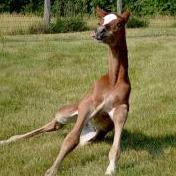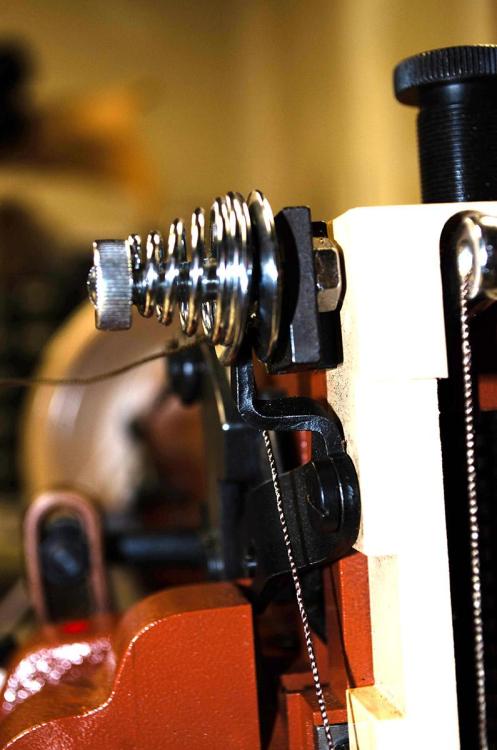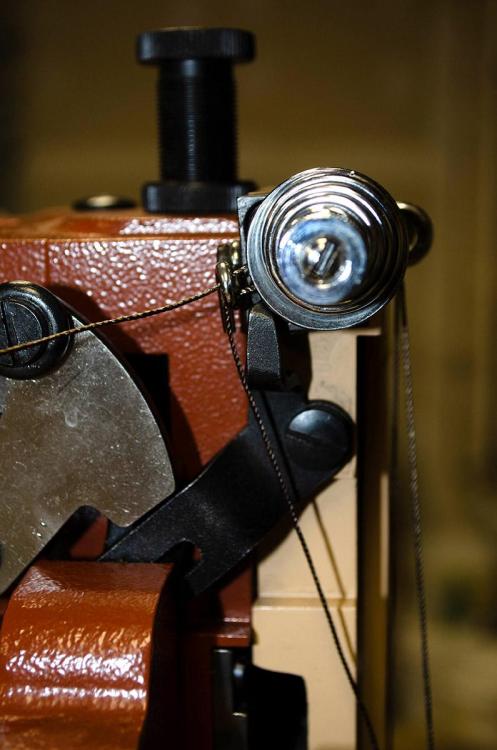-
Posts
1,282 -
Joined
-
Last visited
Content Type
Profiles
Forums
Events
Blogs
Gallery
Everything posted by TomE
-
You could try heating the crease and using it on dry leather. When the temperature is right the crease will glide with less resistance than at room temp. Too hot and it burns the grain of the leather. I use an alcohol lamp to heat the crease. You will feel the heat coming up the shank of the tool when it's about the right temp. Creasers come in many sizes and shapes. Some are easier to use than others. You can reshape them to change the width of the crease line. The Osborne creasers (like all Osborne tools?) need a bit of smoothing and polishing to work really well. Same for the Vergez-Blanchard screw crease. I always crease after finishing the edges of straps - beveling, dyeing, burnishing - then creasing. I repeat the creasing after oiling and before applying conditioner.
-
What type of creaser are you using - fixed or screw crease? What size is it (how close is the crease to the edge)? Is the edge beveled and burnished before creasing? A picture would help. Do you heat the crease or case the leather before creasing? Don't do both. I find that applying light pressure to establish the crease line before bearing down will give me more consistent results. The creaser works best on leather with a firm, even temper. Harness leather is especially nice because of the waxes that lubricate the crease.
-
The diagram is easy to see but it's not easy to calculate stitch spacing from the angles shown. I think it's easier to calculate the inner and outer circumferences then convert the spacing of the outer piece to that for the inner piece as the ratio of circumferences. My point is you will end up with something like 6 and 5.5 stitches per inch for the 2 pieces and I don't know how to accurately mark 2 spacings with a small difference. Won't have to do this with an awl. Skipping a hole doesn't fix the spacing.
-

6 inch hollow ground Splitter blades need sharpening
TomE replied to Doc Reaper's topic in Sharpen it!
Not East Coast but Leather Machine Co has a blade sharpening service for the Class 14 splitter. The blades are hollow ground. I've seen comments stating that they also sharpen blades for other machines. I would search for a local service that sharpens wood working tools.- 11 replies
-
- splitter blades
- 6 inch splitter
- (and 3 more)
-
The math is analogous to the question in the post below - how to calculate the allowance for padding a collar - with the additional consideration of hole spacing that is proportional to the 2 circumferences. That said, it will be a small difference and difficult to accurately mark on the 2 pieces. I'd use an awl.
-
That's for a big dog! Very pretty. I like the color scheme.
-
The Stohlmans mention in their Encyclopedia of Saddle Making that they used lots of neatsfoot compound to good effect, but they acknowledge that pure neatsfoot oil is a better product without explanation. Anybody have an explanation? Waterproofing products typically contain silicon oils that I believe are also petroleum based. I use Saddle Oil, Golden Mink Oil, and Sno Seal on work boots. Pure neatsfoot oil on tack.
-
A glass slicker is useful for burnishing the flesh slide with wax, glue, etc. Loose fibers on the back side might indicate a loose structure overall that makes for a weak, stretchy strap. I mostly use bridle leather with a moss-back (pasted back). A flexible, pasted back can be created with this product that I use if I split the back off bridle leather. It is sold in quarts and gallons. https://campbell-randall.com/product/sup-bt639-g-leather-finish-for-sealing-flesh-side-moss-back-suede-1-gal
-
Polish has waxes and leaves a shiny finish that is somewhat water repellent. Mostly a surface treatment. Leather conditioner creams, balms, etc. aim to add some moisture to the fibers. They soak into the leather and typically leave a satin finish. The choice of finishes depends on the use of the item and your preferences.
-
Learning to sharpen the tools is part of learning to use them. Another reason to start with modestly priced tools. I have enjoyed using CS Osborne tools once I learned how to sharpen them. Like most tools, they need some sharpening when new to work correctly. Stohlman’s book on Leather Tools has some good tips. This cheap Japanese style skiving knife works surprisingly well once it is sharp. https://a.co/d/cuO9tG1
-
Thanks, @jcuk. From the pictures the temper looks similar to the Beiler's apron split that I purchased. Softer than the apron I am using for a pattern. The apron is 6/7 oz (~2.5 mm) and the Beiler's apron split is 7/8 oz (3 mm). Plenty heavy IMO but it will lay differently when working under the horse. The client/friend will stop by tomorrow to check out the leather for his apron. I might order the firm pearl split from Hide House and give him a choice. He's highly skilled and kind enough to shoe a couple of horses for us (I trim the others) so I want to keep him happy. I might make mayself an apron with the other split.
-
I am making a farrier apron and ordered a double bend of pearl gray apron split (7/8 oz) from Beiler's. Was surprised how soft the leather is compared to the apron I am using as a pattern, and my own trimming apron. @bruce johnson's comment about preferring a soft apron split caught my notice, and I am wondering if anyone has experience with Beiler's apron splits for a shoeing apron or other heavy use. I was looking at Hide House as a second choice. They offer firm and soft versions of pearl splits in a a 6/7 oz weight that is similar to what I am used to. Of course, I will ask my farrier friend what he would prefer for this apron. Appreciate any suggestions or your experience with either supplier's apron splits.
-
Impressive figure carving. I like your floral pattern as well. A distinctive piece of art.
-
Good tips! I will look into the speed reducer. Here's a link to the video.
-
Welcome! I make bridles as well, and the Antares bridles are a favorite. Your friend @FrenchMich is friends with sellier Jean-Luc Parisot whose work I have long admired. Not sure if Jean-Luc is doing leatherwork these days but his Instagram account has pictures of many beautiful items.
-
Happy Easter, @chuck123wapati.
-

Cobra class 4 foot pedal: Thread Release
TomE replied to DieselTech's topic in Leather Sewing Machines
Probably an easy fix. I have assembled the release incorrectly before, when I had the cover plate off to adjust the walking foot mechanism. -

Cobra class 4 foot pedal: Thread Release
TomE replied to DieselTech's topic in Leather Sewing Machines
That pointy tip should insert between the tension discs when engaged. You can remove the beige cover plate (2 screws) to reassemble the tension release lever. I would first try just repositioning the lever and reassembling. If it is still misaligned then I would consider that either the tip is bent or the tension disc assembly is missing a spacer that holds it out away from the beige cover plate, more aligned with the lever tip. The first 2 pictures are with the tension release engaged. The third picture is the lever disengaged and the tension discs closed together. -
I think depends on your starting point and process for belts. I have a 4x8 ft work bench in the middle of my space with machines around the outside. I am rolling out sides on the bench to cut straps. I use hand tools on the bench for cutting, edging, creasing, skiving, dyeing, burnishing, and assembling. I like being able to spread out my work.
-
The link didn't work so I couldn't see the defect, but it sounds like lifting of the grain. There is a natural junction between the grain and the underlying flesh layer (corium) that is rather weak and open in structure. It is vunerable to breaking and more so in low quality leather, a defect referred to as "looseness." The "break" of the leather refers to the ripples created when the grain is sharply flexed (concavity). Good quality leather makes fine ripples (fine break) and low quality leather makes coarse ripples with more separation of grain and flesh layers. Blistering caused by uneven wetting of the leather is the same phenomenon. If you're interested in the structure and chemistry of leather the book "Tanning Chemistry. The Science of Leather" by Covington and Wise is a very detailed (685 pp) reference.
-

Where does this piece go? Cobra Class 4
TomE replied to DieselTech's topic in Leather Sewing Machines
That's a thread guide and it goes where you put it, I think. My Class 4 didn't have one and it is not mentioned in the LMC instructions for threading. My Class 26 has this guide and you can route the thread straight through one hole, or make a serpentine pattern through additional holes to add tension to the thread. My Class 4 has been happily running for 3 years without this thread guide. -
I did a Google search "site:leatherworker.net stitching pony" and found quite a few designs.
-

How to fix this mess? Bicycle seat cover.
TomE replied to panchoskywalker's topic in How Do I Do That?
I suggest you cover the seat with a smooth grained leather or vinyl. The suede will create friction and it won't wear well. My first job (51 yrs ago) was working in a bicycle shop assembling bikes. The top bikes had Brooks saddles that are still made today.





